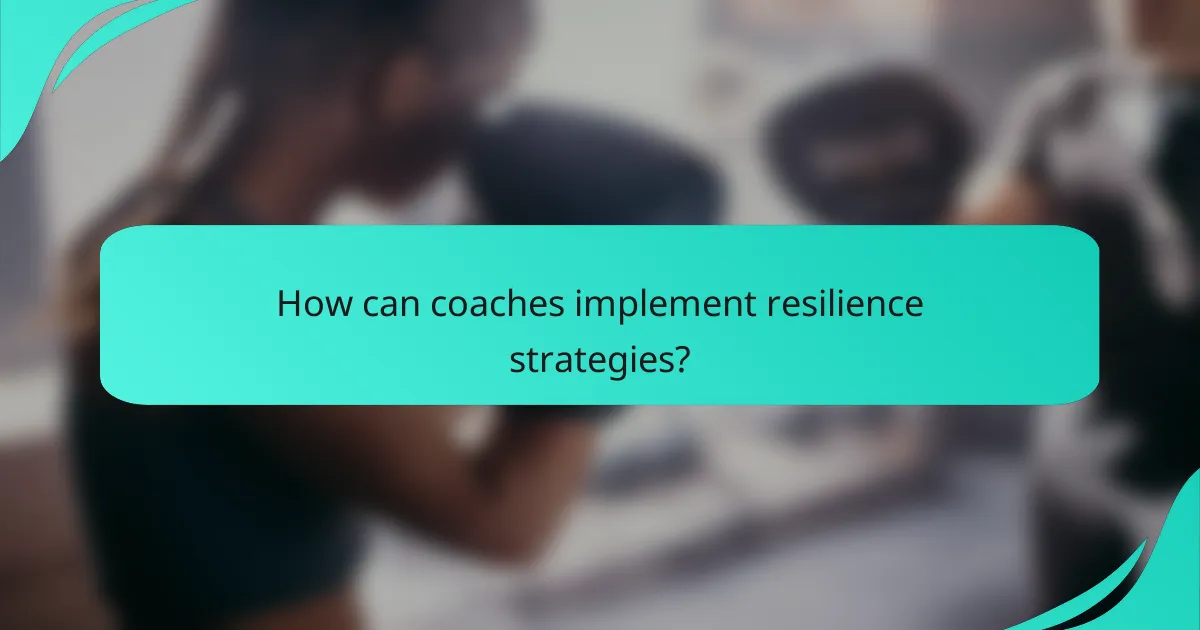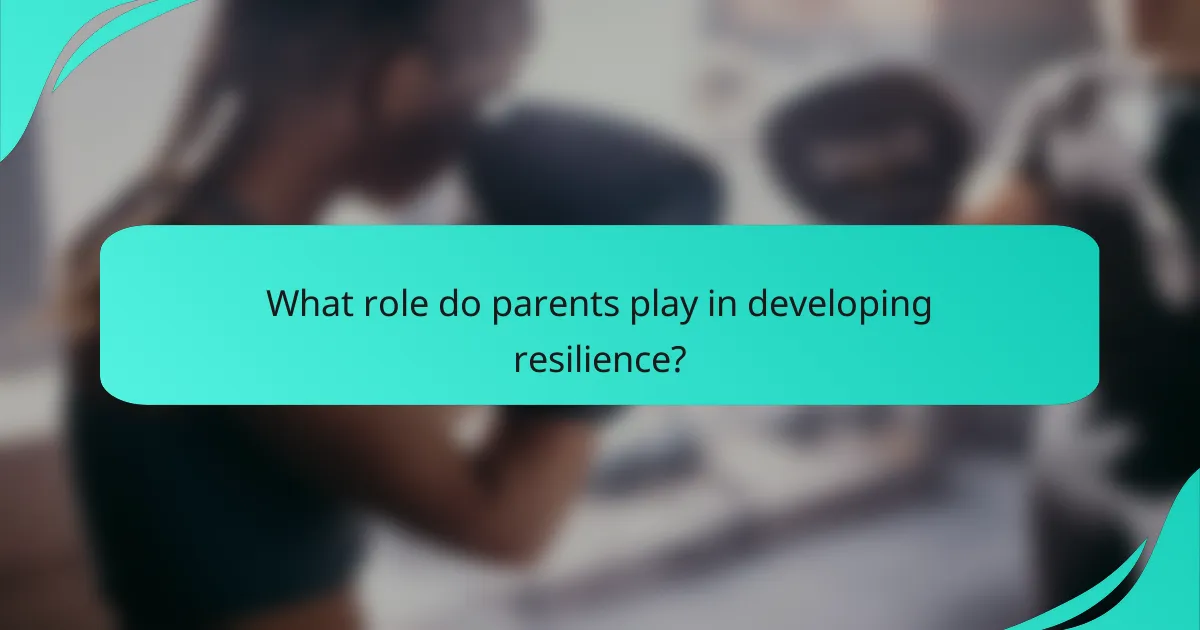Developing resilience in young athletes is crucial for their success both on and off the field. Techniques such as mindfulness training, positive self-talk, and goal-setting not only enhance performance but also promote mental well-being. By fostering a supportive environment and incorporating resilience-building strategies into training, coaches can equip young athletes with the tools they need to navigate challenges and thrive in their sports journey.

What techniques enhance resilience in young athletes?
Techniques that enhance resilience in young athletes include mindfulness training, goal-setting strategies, positive self-talk, visualization practices, and resilience-building games. These methods help athletes cope with challenges, maintain motivation, and improve performance under pressure.
Mindfulness training
Mindfulness training helps young athletes focus on the present moment, reducing anxiety and improving concentration. Techniques such as breathing exercises and meditation can be incorporated into daily routines to enhance mental clarity and emotional regulation.
Practicing mindfulness for just a few minutes each day can lead to significant improvements in stress management and overall well-being. Athletes can use apps or guided sessions to make this practice more accessible and engaging.
Goal-setting strategies
Effective goal-setting strategies involve creating specific, measurable, achievable, relevant, and time-bound (SMART) goals. This approach allows young athletes to track their progress and stay motivated as they work towards their objectives.
Setting both short-term and long-term goals can help athletes maintain focus and build confidence. For example, a short-term goal might be to improve a personal best in a specific event, while a long-term goal could involve qualifying for a championship.
Positive self-talk
Positive self-talk involves encouraging and affirming statements that athletes say to themselves, which can enhance their confidence and resilience. By replacing negative thoughts with positive affirmations, young athletes can improve their mindset and performance.
Encouraging athletes to develop a list of personal affirmations can be beneficial. For instance, phrases like “I am strong” or “I can overcome challenges” can be repeated before competitions to boost self-esteem and reduce anxiety.
Visualization practices
Visualization practices involve mentally rehearsing successful performances, which can enhance an athlete’s confidence and focus. By vividly imagining themselves achieving their goals, young athletes can prepare their minds for real-life challenges.
To practice visualization, athletes can set aside time to close their eyes and picture themselves executing skills perfectly in various scenarios. This technique can be particularly effective before competitions or training sessions.
Resilience-building games
Resilience-building games are activities designed to promote teamwork, problem-solving, and adaptability among young athletes. These games can help athletes learn to cope with setbacks and develop a positive attitude towards challenges.
Examples of such games include obstacle courses that require collaboration and strategy, or team challenges that emphasize communication and resilience. Incorporating these games into training sessions can make learning about resilience fun and engaging.

What are the benefits of resilience development for young athletes?
Resilience development offers young athletes significant advantages, including improved performance, enhanced mental health, and better coping strategies. These benefits contribute to their overall growth, both in sports and personal life.
Improved performance under pressure
Young athletes who develop resilience can maintain focus and composure during high-stakes situations, such as competitions or critical moments in games. This ability to perform under pressure often translates to better results and more consistent performances.
Practicing mindfulness techniques, such as deep breathing or visualization, can help athletes manage anxiety and stay present. Incorporating these strategies into training can prepare them for real-game scenarios.
Enhanced mental health
Resilience contributes to better mental health by equipping young athletes with tools to handle stress and setbacks. This can lead to lower rates of anxiety and depression, fostering a more positive outlook on both sports and life.
Encouraging open communication about feelings and experiences can help athletes process challenges. Support from coaches and parents is vital in creating a safe environment for discussing mental health issues.
Better coping mechanisms
Young athletes with resilience are better at coping with failures and disappointments, viewing them as opportunities for growth rather than insurmountable obstacles. This mindset allows them to bounce back more quickly from losses or injuries.
Teaching athletes problem-solving skills and encouraging a growth mindset can enhance their ability to cope. Regularly reflecting on experiences and identifying lessons learned can reinforce these skills.
Increased motivation
Resilience fosters intrinsic motivation, as young athletes learn to set personal goals and pursue them despite challenges. This self-driven approach often leads to greater commitment and dedication to their sport.
Coaches can help by setting realistic, achievable goals and celebrating progress. Recognizing effort, not just outcomes, can further enhance motivation and perseverance.
Stronger team dynamics
Resilient athletes contribute positively to team dynamics, promoting a supportive and collaborative environment. Their ability to handle adversity can inspire teammates and create a culture of resilience within the group.
Encouraging team-building activities and fostering open communication can strengthen these dynamics. Teams that practice resilience together can develop a shared sense of purpose and unity, enhancing overall performance.

How can coaches implement resilience strategies?
Coaches can implement resilience strategies by fostering a supportive atmosphere, integrating resilience training into regular practices, and maintaining open lines of communication. These approaches help young athletes develop the mental toughness needed to overcome challenges and setbacks in sports.
Creating a supportive environment
A supportive environment is crucial for young athletes to thrive. Coaches should encourage teamwork and camaraderie, allowing athletes to feel safe and valued. This can be achieved through team-building activities and promoting mutual respect among teammates.
Additionally, recognizing individual achievements, no matter how small, can boost athletes’ confidence. Coaches might consider implementing a reward system that acknowledges effort and improvement, fostering a culture of positivity.
Incorporating resilience training in practice
Integrating resilience training into practice sessions can enhance athletes’ coping skills. Coaches can introduce drills that simulate high-pressure situations, helping athletes learn to manage stress and maintain focus. For example, timed drills can create a sense of urgency, teaching athletes to perform under pressure.
Moreover, incorporating mental exercises, such as visualization techniques or mindfulness practices, can further develop resilience. These methods help athletes build mental clarity and emotional regulation, essential for peak performance.
Providing constructive feedback
Constructive feedback is vital for developing resilience in young athletes. Coaches should focus on specific behaviors rather than personal attributes, allowing athletes to understand what they can improve. For instance, instead of saying “You need to be faster,” a coach might say, “Try to push off the ground more forcefully during your sprint.”
Additionally, balancing criticism with praise can motivate athletes to embrace challenges. Coaches should highlight what athletes did well before discussing areas for improvement, creating a more receptive atmosphere for feedback.
Encouraging open communication
Encouraging open communication helps athletes express their feelings and concerns, which is essential for resilience. Coaches should create an environment where athletes feel comfortable sharing their thoughts without fear of judgment. Regular check-ins can facilitate this dialogue, allowing coaches to address any issues promptly.
Furthermore, teaching athletes to communicate effectively with their peers can strengthen team dynamics. Coaches can model active listening and empathy, equipping athletes with the skills to support one another during tough times.

What role do parents play in developing resilience?
Parents play a crucial role in developing resilience in young athletes by providing support, guidance, and a model for coping with challenges. Their involvement can foster a child’s ability to face adversity, learn from setbacks, and maintain a positive outlook.
Modeling resilience behaviors
Parents can effectively model resilience behaviors by demonstrating how to handle stress and setbacks in their own lives. For instance, when faced with challenges, openly discussing their feelings and strategies can teach children valuable coping mechanisms. This modeling encourages young athletes to adopt similar approaches when they encounter difficulties in their sports.
Encouraging independence
Encouraging independence is vital for building resilience in young athletes. Parents should allow their children to make decisions related to their training, such as setting personal goals or choosing practice schedules. This autonomy helps children develop confidence and problem-solving skills, essential components of resilience.
Supporting emotional expression
Supporting emotional expression is key to helping young athletes process their feelings and experiences. Parents should create an open environment where children feel comfortable sharing their emotions, whether they are feelings of joy after a win or disappointment after a loss. Active listening and validating these emotions can strengthen the child’s emotional resilience and ability to cope with future challenges.
